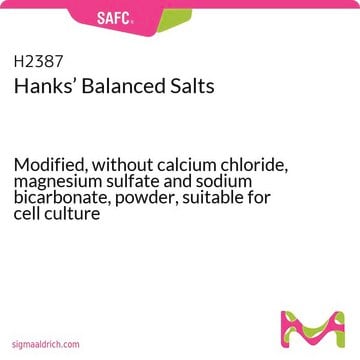H1387
Hanks′ Balanced Salts
Modified, without phenol red and sodium bicarbonate, powder, suitable for cell culture
Synonym(s):
HBSS
Sign Into View Organizational & Contract Pricing
All Photos(1)
About This Item
Recommended Products
Looking for similar products? Visit Product Comparison Guide
General description
Balanced salt solution (BSS) serves as an irrigating, transporting, and diluting fluid while maintaining intra- and extracellular osmotic balance. It also provides cells with water and certain bulk inorganic ions essential for normal cell metabolism. BSS when combined with a carbohydrate, such as glucose, provides the principal energy source for cell metabolism. In addition, it also provides a buffering system to maintain the medium within the physiological pH range (7.2-7.6).
Application
Hanks′ Balanced Salts has been used:
- for diluting digested tissues during isolation of pancreatic blood vessels
- for washing mouse intestinal mucosal cells before lysis and sonication
- as an immersion solution to test the in vitro bioactivity of poly(ε-caprolactone)-coated hydroxyapatite scaffold derived from cuttlefish bone
Quantity
Formulated to contain 9.7 grams of powder per liter of medium.
Reconstitution
Supplement with 0.35 g/L sodium bicarbonate.
Other Notes
The pH is adjusted after addition of sodium bicarbonate. Investigators who work with stem cells or cell clones frequently prefer media without phenol red.
Storage Class Code
11 - Combustible Solids
WGK
WGK 3
Flash Point(F)
Not applicable
Flash Point(C)
Not applicable
Personal Protective Equipment
dust mask type N95 (US), Eyeshields, Gloves
Certificates of Analysis (COA)
Search for Certificates of Analysis (COA) by entering the products Lot/Batch Number. Lot and Batch Numbers can be found on a product’s label following the words ‘Lot’ or ‘Batch’.
Already Own This Product?
Find documentation for the products that you have recently purchased in the Document Library.
Customers Also Viewed
Till Jurgeleit et al.
Materials (Basel, Switzerland), 11(4) (2018-03-24)
FeMn alloys show a great potential for the use as a biodegradable material for medical vascular implants. To optimize the material properties, with respect to the intended application, new fabrication methods also have to be investigated. In this work different
Magalie Boucher et al.
Toxins, 13(3) (2021-03-07)
The fungal metabolite sporidesmin is responsible for severe necrotizing inflammation of biliary tract and liver of livestock grazing on pasture containing spores of Pithomyces chartarum that synthesizes the toxin. The toxin is secreted into bile causing the erosion of the
Ehsan Mostaed et al.
Acta biomaterialia, 105, 319-335 (2020-01-27)
Zn-based alloys are recognized as promising bioabsorbable materials for cardiovascular stents, due to their biocompatibility and favorable degradability as compared to Mg. However, both low strength and intrinsic mechanical instability arising from a strong strain rate sensitivity and strain softening
Dajana Milovac et al.
Materials science & engineering. C, Materials for biological applications, 34, 437-445 (2013-11-26)
In the present study, poly(ε-caprolactone)-coated hydroxyapatite scaffold derived from cuttlefish bone was prepared. Hydrothermal transformation of aragonitic cuttlefish bone into hydroxyapatite (HAp) was performed at 200°C retaining the cuttlebone architecture. The HAp scaffold was coated with a poly(ε-caprolactone) (PCL) using
Andrew I U Shearn et al.
Frontiers in cell and developmental biology, 8, 367-367 (2020-06-13)
Small extracellular vesicles (sEVs) are those nanovesicles 30-150 nm in size with a role in cell signalling and potential as biomarkers of disease. Nanoparticle tracking analysis (NTA) techniques are commonly used to measure sEV concentration in biofluids. However, this quantification
Protocols
Powdered media and salt mixtures are extremely hygroscopic and should be protected from atmospheric moisture.
Our team of scientists has experience in all areas of research including Life Science, Material Science, Chemical Synthesis, Chromatography, Analytical and many others.
Contact Technical Service






